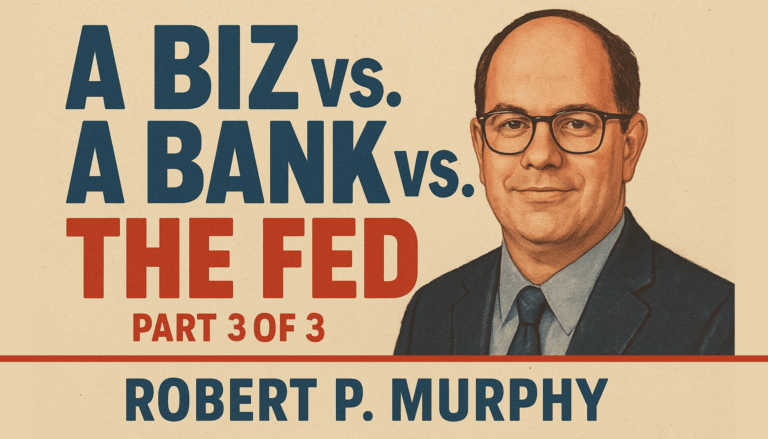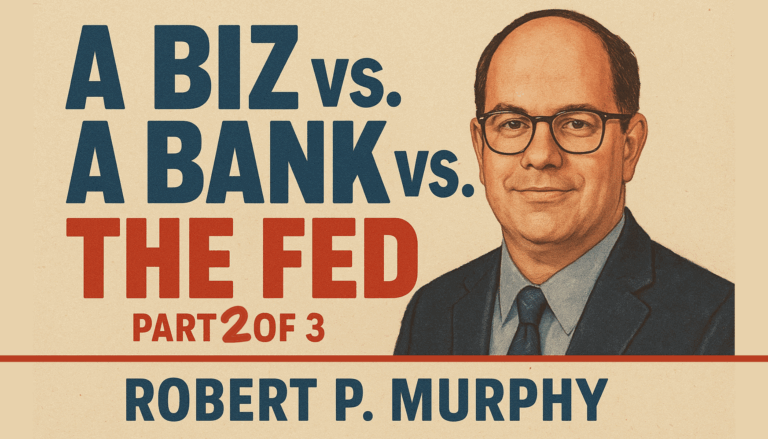I was recently in a debate on ZeroHedge arguing that the US dollar would forfeit its world reserve currency status sooner than most analysts think. One of the strongest points (rhetorically speaking) by the other side was that the Eurodollar market would solidify the USD, such that any shock to the system would, paradoxically, cause the dollar to strengthen against the euro, yen, pound, and other major currencies.
Since this was such an important part of the argument, I had Brent Johnson—of “dollar milkshake” fame—come on the Human Action podcast to flesh out our dispute. We covered the ground where we both agreed, and honed in our actual disagreement: Brent was arguing that the fractional-reserve, debt-based Eurodollar system meant that the quantity of dollars had to keep expanding, or else the whole thing would become unsustainable. Certain European individuals or firms who owed other Europeans USD-denominated debts would find it harder to obtain dollars during the crunch, which would spark a wave of defaults. But this would cause the quantity of Eurodollars—which are accounting creations of the private banking system, not of State-issued fiat currency—to itself begin contracting. Ultimately, the restriction in USD supply and the scramble for liquidity in a crisis would send the dollar skyrocketing against other currencies.
For my part, I have no doubt that we might see a European crisis with just those features in the next few years. My more modest point was that nothing will arrest the medium- and long-run decline of the dollar’s global importance, because the slippage of the USD itself will only cause it to weaken against other currencies. In particular, if the reason the global quantity of Eurodollars shrinks, is that foreigners want to reduce their holdings of USD-denominated assets, then in that scenario it becomes easier to service your USD debts. Far from leading to defaults, borrowers in USD would pay back with greater likelihood. So the Europeans could gradually unwind their exposure to the USD if they wanted; nothing in the system would push them back toward dollar hegemony.
How Banks Create More Dollars in the United States
In order to spell out my logic regarding bank creation of USD in foreign countries, I first need to explain the mechanics in the domestic context. In other words, I will, in the rest of this post, spell out how US banks create more US dollars right here in the US. For the rest of this section, I reproduce a section from my free book from the Mises Institute, Understanding Money Mechanics:
“For a community whose base money is hunks of gold, the reserves held in bank vaults would of course be determined by how much of the yellow metal had been mined (and fashioned into bars or coins). Yet today in the United States, because the underlying base money is the US dollar itself—meaning that it currently has no redemption option but is simply fiat money—the reserves held in bank vaults are green pieces of paper featuring US presidents. In addition, a commercial bank in the US could also satisfy its reserve requirements by having (electronic) balances on deposit with the Federal Reserve. Legally speaking, a commercial bank can itself hold a “checking account” with the Fed, and its deposit balance is “as good as” currency that the commercial bank holds in its own vaults.
Because of this situation, the Federal Reserve is able to affect the monetary base through its actions. Suppose that Fed officials want to adopt an “easier” policy that increases the quantity of money in the system and also (other things equal) tends to push down short-term interest rates. To accomplish these goals, the Fed can simply buy assets, writing checks on itself.
To give a specific example, suppose the Fed buys $10 million worth of Treasury bonds originally held by a dealer in the private sector. The Fed obtains the $10 million in bonds, adding them to its balance sheet. The seller of the bonds, in turn, receives payment in the form of a check written on the Federal Reserve. Legally, the Fed can’t “bounce a check”—there are no limits operationally on how much it can spend. When the dealer that sold the bonds deposits the check into its own bank account (at Citibank, say), the dealer’s checking account balance goes up, of course, by $10 million.
Now here is the important part of the story: Citibank passes along its customer’s deposited check to the Fed, which then credits Citibank’s account with the Fed by $10 million as well. At this initial stage, Citibank itself is just treading water; its liabilities have gone up by $10 million (because the bond dealer now thinks it has an extra $10 million in its checking account with Citibank), but its assets have also gone up by $10 million—represented by Citibank’s higher account balance with the Fed.
Yet look at what has happened. From Citibank’s perspective, a customer effectively just deposited $10 million in new base money that entered the financial system at the moment the Fed wrote the initial check. It is as if new gold coins had suddenly entered our hypothetical town from the earlier discussion and customers had deposited the new coins with the bankers. As we saw earlier, an influx of newly deposited base money sitting in the vaults of the commercial banks allows for new lending by the banks.
The same process happens here. Because Citibank’s reserves have gone up by $10 million, while its total outstanding customer deposit balances have also gone up by $10 million, it is now holding more than it needs to. Citibank can effectively lend out some of the newly deposited money, because it doesn’t need to hold the entire $10 million in new reserves to back up the $10 million in extra checking account funds now held by its customers.
If the commercial banks follow a 10 percent reserve rule and the system becomes “fully loaned up” after the Fed’s injection of $10 million, then the total increase in M1 will ultimately be $100 million. To sum up: the Fed’s decision to buy $10 million in bonds created $10 million in new (base) money, but then the banking system itself effectively creates $90 million in new (broader) money on top of it.
As before, we point interested readers to the footnotes for further reading that spells out this process more exhaustively. For our purposes here, there are two crucial takeaway messages:
1. In our current fiat money system, the Federal Reserve creates new base money when it buys assets by writing checks on itself. Going the other way, the Federal Reserve destroys base money by selling assets (or by letting its assets mature and refraining from rolling over the proceeds). These actions do not require a literal printing press, as they can be achieved through electronic operations.
2. When the Fed injects new base money into the system, it will often be deposited into commercial banks, where it will add to reserves. Under fractional reserve banking, the new reserves give the commercial banks the ability to pyramid new money (as measured by M1, M2, etc.) on the system through the process of granting new loans. Going the other way, when the commercial banks restrict their loan portfolios or the public withdraws base money from the banks, it causes the broader aggregates (M1, M2, etc.) to shrink.”
Tune In Next Time!
In next week’s post, I will take the above framework and show what happens to foreign banks that deal in USD accounts, when their customers reduce their desire for exposure to the US dollar. As we’ll see, the quantity of US dollars in that particular economy will shrink, while the USD will fall against that country’s currency.
NOTE: This article was released 24 hours earlier on the Infinite Banking (IB) 3.0 – The Future of Finance Group
Dr. Robert P. Murphy is the Chief Economist at infineo, bridging together Whole Life insurance policies and digital blockchain-based issuance.
Twitter: @infineogroup, @BobMurphyEcon
LinkedIn: infineo group, Robert Murphy
Youtube: infineo group
To learn more about infineo, please visit the infineo website

